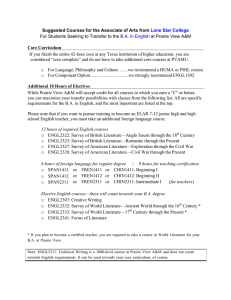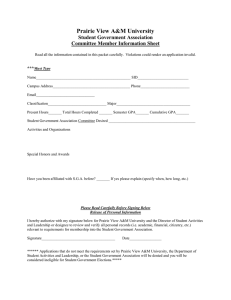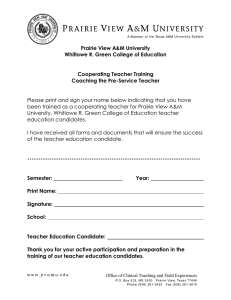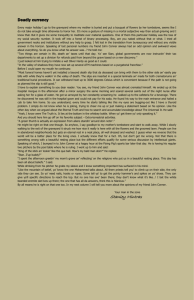From Education to Engagement Date: Transcript 1: Recording Length
advertisement
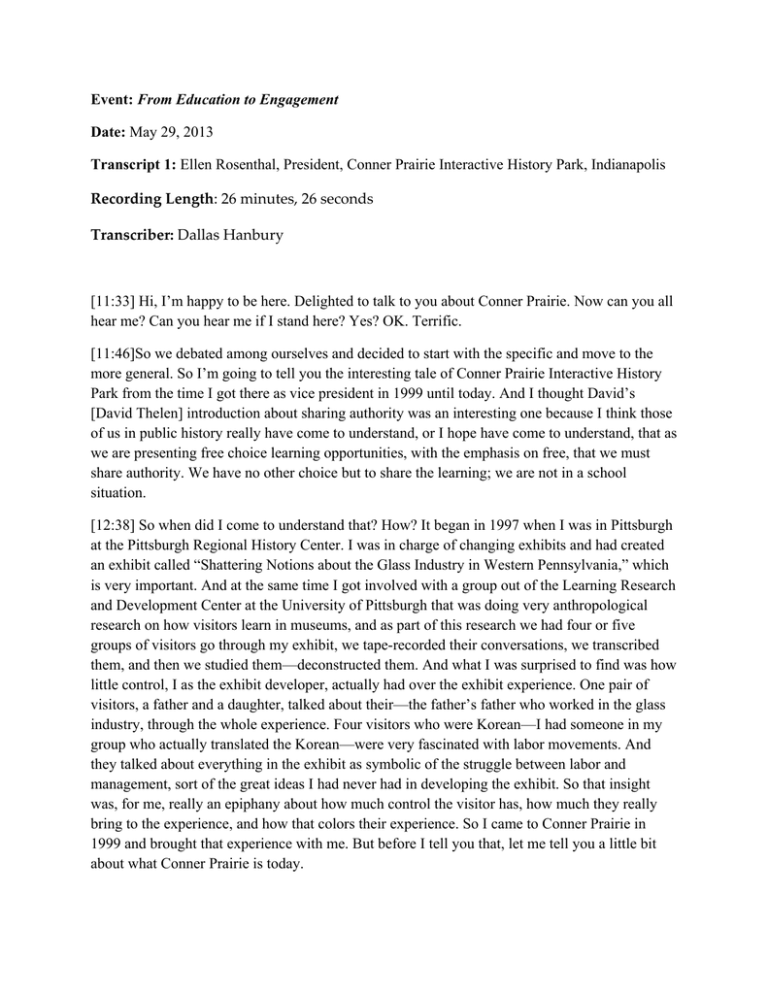
Event: From Education to Engagement Date: May 29, 2013 Transcript 1: Ellen Rosenthal, President, Conner Prairie Interactive History Park, Indianapolis Recording Length: 26 minutes, 26 seconds Transcriber: Dallas Hanbury [11:33] Hi, I’m happy to be here. Delighted to talk to you about Conner Prairie. Now can you all hear me? Can you hear me if I stand here? Yes? OK. Terrific. [11:46]So we debated among ourselves and decided to start with the specific and move to the more general. So I’m going to tell you the interesting tale of Conner Prairie Interactive History Park from the time I got there as vice president in 1999 until today. And I thought David’s [David Thelen] introduction about sharing authority was an interesting one because I think those of us in public history really have come to understand, or I hope have come to understand, that as we are presenting free choice learning opportunities, with the emphasis on free, that we must share authority. We have no other choice but to share the learning; we are not in a school situation. [12:38] So when did I come to understand that? How? It began in 1997 when I was in Pittsburgh at the Pittsburgh Regional History Center. I was in charge of changing exhibits and had created an exhibit called “Shattering Notions about the Glass Industry in Western Pennsylvania,” which is very important. And at the same time I got involved with a group out of the Learning Research and Development Center at the University of Pittsburgh that was doing very anthropological research on how visitors learn in museums, and as part of this research we had four or five groups of visitors go through my exhibit, we tape-recorded their conversations, we transcribed them, and then we studied them—deconstructed them. And what I was surprised to find was how little control, I as the exhibit developer, actually had over the exhibit experience. One pair of visitors, a father and a daughter, talked about their—the father’s father who worked in the glass industry, through the whole experience. Four visitors who were Korean—I had someone in my group who actually translated the Korean—were very fascinated with labor movements. And they talked about everything in the exhibit as symbolic of the struggle between labor and management, sort of the great ideas I had never had in developing the exhibit. So that insight was, for me, really an epiphany about how much control the visitor has, how much they really bring to the experience, and how that colors their experience. So I came to Conner Prairie in 1999 and brought that experience with me. But before I tell you that, let me tell you a little bit about what Conner Prairie is today. [14:43]This is a map of Conner Prairie. We’re outside of Indianapolis. Today, we have five history experience areas, from the original 1836 prairie town created in 1974 which reveals the story of the settlers to Indiana, to a Civil War, [a] balloon area that tells the story of the first airmail delivery, Native Americans. It’s not really important what we have, except that it’s a big campus, 200 acres, with three indoor areas. And we rank among the largest segments of museums in America. So we, last year had 323,000 people who attended. We have a 10 million dollar budget this year. So I just tell you that to put it in scope, not that there are lessons that can be learned for every size museum; some of the things we’ve done will not be directly translatable. What is remarkable about Conner Prairie is what’s happened to our admission, our general admission, this is general daytime admission. And I’m showing you this, like, the, end of a detective story where you get to see who’s murdered and who did it at the end. So you know what happens in the end, and now I’m going to take you back and show you how it happened. So the museum was founded in 1974. By 1997 it had hit an all-time low in attendance. Nothing had changed essentially for those years, and most of the visitation was fourth grade field trips. When we did focus groups, when I came, people said that “Why should we go back? Nothing ever changes.” They thought that once in a life time counted and the fourth grade field trip covered it all. So we had some major challenges. I will say, you’ll notice, and we were not alone, [the] history museum field has generally been struggling from its blossoming efflorescence at the time of the bicentennial in 1976, when there was a general heightened interest in American History. If you’ll look at Sturbridge [Old Sturbridge Village] or Colonial Williamsburg, you’ll see that the height of their visitation was in the 1970s, and they’ve been on a downward slope ever since, and Conner Prairie was on the same trajectory. [17:19] In 1998 when I went to a meeting of a group of the twenty-five largest outdoor history museums in the country, called the Outdoor History Museum Forum, one of the CEO’s said, “Let’s face it, we’re in crises. And the problem is that history teachers in schools have really turned people off history. And we really don’t have a choice. We really have a problem.” So, I had to admit, having moved there, that Conner Prairie had a problem. Not only had it not changed, but I had three boys who were a really effective focus group when I moved there. They were thirteen, ten, and six, and I took them through, and they said to me, “Mom, your old museum was better. This is really lame.” And one of my favorite lines was my youngest, when I once, Conner Prairie uses first person interpreters to present its, to fulfill its mission, and a lot of the first interpreters are retired, so I said to my youngest son once, “Do you want to go out to Conner Prairie with me?” And he looked at me, as a kid will want to do, just laid it out, and he said, “Sure mom, let’s go talk to old people.” So, we definitely had a major challenge. So here we are, these are actually images, these are PR images from the 1980s. Conner Prairie was the first American living history museum. Plimoth [Plantation] opened a couple of months after us, and was generally regarded as one of the most authentic museums in the country. By the mid 1990s, and by the time I came in 1999, authenticity had come to matter most. Whereas when it was founded, it was considered this incredibly innovative place that was dealing with history in a new way, where experience mattered. In the intervening twenty years, it became the staff’s 2 particular interest in the kind of buttons that were on costumes, whether the costumes were handsewn, and whether they were doing things exactly as they had been in 1836. So, each interpreter also had to deliver specific information, even though they were speaking in first person, they all had three major points to deliver, there were about eighteen stations, so they gave about six minute monologues. So if you were to go through, you went to eighteen six minute monologues. The interpreters had to guard original houses, and it was mostly fourth grade field, school visits. It was sort of other-worldly when I first visited. I couldn’t really believe it. I would say things like, “This wedding that you do in June, on one day in June, you spend three weeks preparing for it. If people happen to see it, it’s great. But if they don’t, they miss out. Why don’t we do the same wedding every day in June? That would be, we can celebrate June as wedding month.” And I was told by the staff “that can’t happen, because people only get married once.” So, we had major challenges. And I was in the vice-president’s role, so I had some time on my hands, and I thought, “What do I do?” Well, the, before, the visitor, the learning studies that I had done in Pittsburgh were a real epiphany for me: “how about if I bring them to Conner Prairie and see if they can help change the staff?” So that’s exactly what I did. I went back to the Learning Research and Development Center at Pitt; they mentored some studies. I did the studies along with a colleague, Jane Hettrich[?], and even from a pilot study what we found was that interpreters really function best not as dispensers of information, but as catalysts for engagement of the whole group, or family unit, that monologue actually impeded conversation and learning, that interpreter’s style and ability to engage was critical. So when we say it impeded, we were looking at a format to measure learning through the conversations that visitors were having and looking at conversation as both the process and the product of learning, and seeing when visitors got to higher levels of discussion about information they were seeing. So, just to give you an example, I could say, the first thing visitors do is say, “This is a glass.” The next thing they say is “My aunt Tilley has a glass just like this.” And really where you want them to go is to really begin to understand [that] in 2013 we have plastic glasses—that’s a sign of our society today, that nothing is real, or very little is real. I’m making this up as I go along, but what we found is that the monologue was impeding, what would happen is people would lecture, the visitor would say, “Uh-huh,” and try and get away as fast as they could. If there were kids involved, the kids were wandering off, and the parents were concerned that the kids were being rude, and they would grab them by the shoulders and make them stay in one place. So we decided that, and what we really learned is that the guest is ultimately in charge of what they learn, and that really is that what they learned was really dependent on what they brought into the experience. So I use this cartoon, although, just to show that everybody has their own thing in their head that they bring to everything they do. This cartoon seems to be about people thinking about themselves as dogs, so I don’t really understand it, but every person’s response in a museum setting or an archival setting, has to do with what they think of their identity, what their prior experiences are, what their expectations of the visit are, um, who they’re with, and that is a tremendous influence on what happens. 3 [24:10] So what happened in our learning study? So we did a pilot, and then we hooked up with a sociolinguist at the Ball State University, and did a whole formative analysis of fifty families, and then made changes and then went back and looked at what was happening again. We came to see learning in an entirely different way. So, if in pre-2001 it was filling a glass, post 2001 it was rolling a snowball. And when we say rolling a snowball, it means that the areas already that are already roughened, that are roughened by previous experience or previous learning, by the fact that your kid studied Colonial America and thought about not having electricity and what that meant, by the fact that your ancestor came from Indiana or didn’t come from Indiana, or the fact that you studied the Civil War. I mean anything. Learning tends to cling to what you already know. And I would say it also then what you take out of the museum visit then goes back and goes on over time to be sort of a foundation for further learning, particularly for children, I would say, in the classroom. So the Opening Doors interpretative approach was created. And that was to really value guest interest. We completely, this was a tremendous revolution at Conner Prairie. So we ended the information dump. We completely did away with post goals. And our interpreters and front-line staff had been evaluated on whether they got information across. So we took that out of their requirements. We removed all breakable objects. I am trained as a curator. And I know you all have learned about the power of objects, or most of you have. Well in the seven or eight years since we did this, to remove all objects that were, had unique provenance, we have not had one complaint about there not being unique objects. We have the capacity to make reproductions; we filled the space with reproductions. [26:24] We created, and when I say we I mean not administration, but really after the studies were done it became a staff problem to try and figure out the solutions, and the staff created a toolbox of both hands-on and minds-on techniques to meet the needs of visitors. They set up environments in the beginning, and we’ll talk a little bit about that, and we completely changed the way we trained them. So, in the past they had only been trained in the history—we actually changed the way we hired them too. So in the past they’d only been trained in history, and they sort of picked up the skills through apprenticeships on the ground. After Opening Doors we started to train them in improv, in cultural differences, in developmental stages and how to talk to children, in engagement techniques and how to work with the toolbox. It would take us, someone said, “Do you use volunteers?” Mostly we use paid staff, because it takes us so much investment to get someone to get ready to go on the grounds, to really be able to work with a range of visitors with different interests. So when we came back and studied what was going on again, what did we find? [27:42] So this is showing you, before, you’re not supposed to read this, so don’t. It’s really just symbolic. Before, there were monologues. After we made changes there was one: longer stay time. But then there was actually conversation. And not just conversation that was taking place between the visitors, which is what used to happen. They would walk away from an interpreter and have their own conversations, often with their own misinformation. But they had conversations with the interpreter, with the interpreter drawing everybody in the family or in 4 group, into the conversation. And you can see after that, if the yellow is the interpreter, white is the guest, that they are really having a conversation. And there were also, as we measured, higher degrees of learning, they were really moving up in their ability to really think more broadly about what was going on. They were, if you will, learning. [28:45] Just to give you a sense, and this was not just happening with free-choice visitors, but students as well, that the teachers noticed. That they had stopped, the students were no longer just getting a speech and moving on, but they were able to participate. We developed hands-on techniques that worked for whole groups of kids, were they’d pull against oxen and all sorts of wild things. The staff, in the meantime, created a new mission statement. And I think you can see from here that the old mission statement was to educate the public. So many museums have these mission statements; to preserve, to educate, to present—I forget what the triplet is. But our staff as a whole, we started asking each other, “What actually is our role, what can we actually do for visitors that come in?” First of all, we changed our language so we now speak of “guests.” But in the end we realized when someone pays their money, or comes in for free, we can’t test them. The best we can do is be the spark—to inspire curiosity and foster learning, that we can do that if we do it really well, and that is our goal. [30:03] So, for those of you who know, Conner Prairie was actually going through a governance dispute during this time. So we had, for all intents and purposes, no board while the “Opening Doors” was being developed and being implemented. So the staff actually had the opportunity to develop a mission statement, which was great, without the, with just the rubber stamp from a very, sort of a symbolic board. And we, the mantra came to be “put the guests at the center.” And what I think as the administrator was the most wonderful about this, and when I give talks, is not that this happened, but really, that it was a, that it became a grassroots movement. So if you went to Conner Prairie right now, and this actually just happened recently, no one knows that I was the first one to do a learning study, they have no idea I was even involved, or even know anything about it. This is something the staff owns at this point. This is who they are, it’s sort of part of their DNA, it’s part of the culture now, and they started to come up with ways, and you know, as Barbara [Franco] said, “You talk to visitors, if you’re talking to the visitors, you know what engages people.” And they [the staff at Conner Prairie] were the ones that started to come up with ideas. So, as one of our board members says, “Opening Doors is now our secret sauce.” Because it’s really about what engages people, what brings them in to learning in ways that they don’t even sort of understand. And I will tell you in general, it works for guests. But what I’ve actually found is that it works for stakeholders, it works for donors, it works for the board; that whole idea of sort of thinking through what engages people, what draws their interest, what makes them want to participate, is sort of the clue to what makes everything work. [32:07] So, the staff developed “Animal Encounters,” where we actually breed animals for socialization. So it used to be that our sheep were bred, and they all gave birth in March before we actually opened our doors. And then head of agriculture said, “You know, I can change that. I can actually breed them so they deliver throughout the season.” And I said “Don’t explain to 5 me—Do not explain to me how that happens.” But he now has had multiple generations of breeding animals that can be touched, that don’t get startled by huge groups of kids, and I just have to tell you this, because it always makes everybody groan. So if our animals, our lambs and goats and, pigs cannot be socialized, but, um, calves are very well socialized, if they really do well with people, they get to stay and work with the guests, and procreate, and if they don’t, we have a wonderful partnership with a gourmet delicatessen downtown. So, sorry, it’s true. Also, another thing a staff member came up with, which I didn’t even know about until it was practically in place, is [to] choose an avatar, which was a videogame overlay on 1836 Prairie Town, where you get to choose your character, and what you see on the bottom is a big wheel, you spin or you can choose a character, and you get to do chores and then move to the next level, and you can earn a token and redeem it at the store. And kids love it, they really love the avatar of the criminal, I don’t know why. [34:01] So, I’m just going to sum, some of the other sort of tenets that we follow, is to engage the entire family in memorable experiences. I’ve been saying this for years, whatever experience you are creating, if you want families to be there, if the children aren’t engaged, you’ll lose the parents. And I know this from having the frustration of trying to go through a history exhibit with my kids, if they’re not engaged, you can’t enjoy it. And if the parents aren’t engaged, you’ll also lose the children. How long can you stand and watch them climb through a fire truck in a children’s museum? I wish children’s museums would listen to me. So we try and balance it out. Some of you may know what I’m talking about. We use the Pixar approach. So, as Pixar sort of creates multiple layers, we think through what the learning objectives are. [34:54] This is actually the new “1863 Civil War Journey,” which is the incorporation of first person interpretation and some technology, and we, it was incredibly difficult, but we worked through it so that it worked together, so a family can go in it together, and they all can take things away, and they can share the experience and talk about it together. And we’ve overheard some wonderful conversations between parents and children about some really weighty issues related to war and the attitude of Hoosiers, of people in Indiana, towards the Civil War. So, it’s been very rewarding. [35:36] Engineer your environment, think through what ways that will engage different ages, that applies for museums, archives. Think through how you set things up so there will be hooks. Prioritize guest comfort and need, this goes without saying. And then, David [Thelen] will never forgive me if I don’t say something about “Follow the North Star,” which is the program, which is, it was developed in 1998, before “Opening Doors.” It is the evening, the evening program is for ages twelve and up. And, as I said, we use age-specific programming judiciously, so “Follow the North Star” is an adult program. It runs at night, we have a day-time program for middle school students. It is such a powerful program. It is sort of the epitome of the museum experience that tells you more about yourself, as much about yourself as it does about the historical moment. So we keep it going, even though it loses money. But it’s so mission centric. And the day-time program, we cannot keep up with the demand. We just keep expanding, and 6 expanding, and expanding the amount of time we devote to it. We do have, we have installed special kids areas, because it feeds membership. [37:02] And the other thing, I would say, as you are thinking about public history, which we think about. Location, location, location. I’m talking about families and children, because that is where we are. We are not in a tourist destination. We are in an area that has tons of families with children. And we made a deliberate decision that that was going the core focus, our core focus, that we wouldn’t survive focusing on adults. You may decide that you can survive if you are the Hermitage, and you have a huge tourist audience, you can focus on adults and get away with it. We wouldn’t, we would have not survived. So we pay mind, also, to the latest research on what children’s gender and age preferences are. And I refer you to wonderful research, by PGAV, at PGAVdestinations.com. [37:59] We work variety into the visit, create a symphony of experiences, because it is variety that keeps learning fresh. Even if you love mashed potatoes, if you had an entire meal of mashed potatoes, you would be sick of it by the main course. And it’s the same thing with first-person, we’ve deliberately changed up the kinds of experiences, and Barbara [Franco] I think can confirm in exhibits too, you try and change up the view--the thinking, so from animal experiences, to storytelling, to hands-on. And then, as I said, consider who is coming to your site. Always see from the guests’ perspective, and adjust accordingly. And that happens on the microlevel, and that happens on the macro-level. And the last thought, how do you and your staff think about learning? This was actually the biggest obstacle to overcome at Conner Prairie--was to get the staff to understand, as Yeats said, my favorite quote, “Education is not the filling of a pail, but the lighting of a fire.” To them, education meant sitting at a desk, and learning so you could take a test. When I, when we suggested, that we loosen that up, they said, “But that’s not fulfilling our mission.” So to get them to see learning in a whole different way was a huge campaign and a major undertaking, which I’m happy to say we’ve come out on the other side of. So thank you very much. 7


